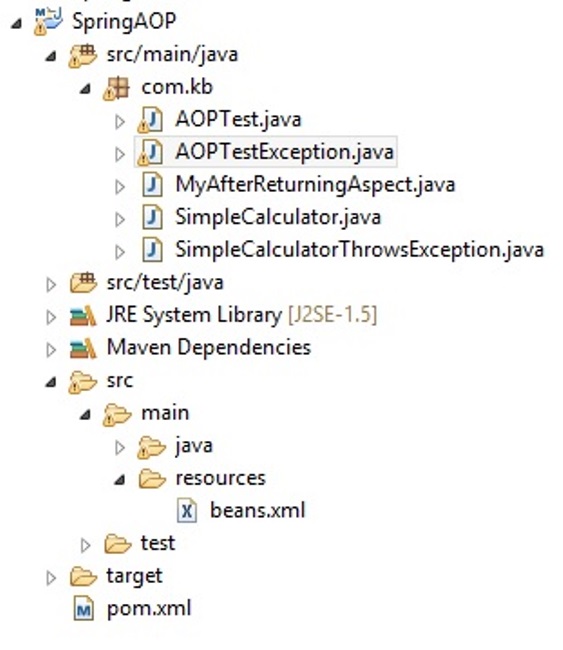AfterReturning Aspect XML implementation example
create a spring maven project so that we can manage our dependencies in the pom.xml easily.
Project structure looks like below

Define the pom.xml file as below to include AspectJ jars and spring jars
- <project xmlns="http://maven.apache.org/POM/4.0.0" xmlns:xsi="http://www.w3.org/2001/XMLSchema-instance"
- xsi:schemaLocation="http://maven.apache.org/POM/4.0.0 http://maven.apache.org/xsd/maven-4.0.0.xsd">
- <modelVersion>4.0.0</modelVersion>
- <groupId>Spring</groupId>
- <artifactId>SpringAOP</artifactId>
- <version>0.0.1-SNAPSHOT</version>
- <packaging>jar</packaging>
- <name>SpringAOP</name>
- <url>http://maven.apache.org</url>
- <properties>
- <project.build.sourceEncoding>UTF-8</project.build.sourceEncoding>
- </properties>
- <dependencies>
- <dependency>
- <groupId>org.springframework</groupId>
- <artifactId>spring-core</artifactId>
- <version>4.2.4.RELEASE</version>
- </dependency>
- <dependency>
- <groupId>org.springframework</groupId>
- <artifactId>spring-context</artifactId>
- <version>4.2.4.RELEASE</version>
- </dependency>
- <dependency>
- <groupId>org.aspectj</groupId>
- <artifactId>aspectjrt</artifactId>
- <version>1.7.3</version>
- </dependency>
- <dependency>
- <groupId>aspectj</groupId>
- <artifactId>aspectjweaver</artifactId>
- <version>1.5.4</version>
- </dependency>
- <dependency>
- <groupId>junit</groupId>
- <artifactId>junit</artifactId>
- <version>3.8.1</version>
- <scope>test</scope>
- </dependency>
- </dependencies>
- </project>
<project xmlns="http://maven.apache.org/POM/4.0.0" xmlns:xsi="http://www.w3.org/2001/XMLSchema-instance"
xsi:schemaLocation="http://maven.apache.org/POM/4.0.0 http://maven.apache.org/xsd/maven-4.0.0.xsd">
<modelVersion>4.0.0</modelVersion>
<groupId>Spring</groupId>
<artifactId>SpringAOP</artifactId>
<version>0.0.1-SNAPSHOT</version>
<packaging>jar</packaging>
<name>SpringAOP</name>
<url>http://maven.apache.org</url>
<properties>
<project.build.sourceEncoding>UTF-8</project.build.sourceEncoding>
</properties>
<dependencies>
<dependency>
<groupId>org.springframework</groupId>
<artifactId>spring-core</artifactId>
<version>4.2.4.RELEASE</version>
</dependency>
<dependency>
<groupId>org.springframework</groupId>
<artifactId>spring-context</artifactId>
<version>4.2.4.RELEASE</version>
</dependency>
<dependency>
<groupId>org.aspectj</groupId>
<artifactId>aspectjrt</artifactId>
<version>1.7.3</version>
</dependency>
<dependency>
<groupId>aspectj</groupId>
<artifactId>aspectjweaver</artifactId>
<version>1.5.4</version>
</dependency>
<dependency>
<groupId>junit</groupId>
<artifactId>junit</artifactId>
<version>3.8.1</version>
<scope>test</scope>
</dependency>
</dependencies>
</project>
Let’s create a class which contains a business logic on which we apply Advice.
- package com.kb;
- public class SimpleCalculator {
- public int add(int x,int y){
- return x+y;
- }
- public int subtract(int x,int y){
- return x-y;
- }
- }
package com.kb;
public class SimpleCalculator {
public int add(int x,int y){
return x+y;
}
public int subtract(int x,int y){
return x-y;
}
}This class has 2 methods where each method performs some business logic,which is addition and subtraction.
Now let’s write the Aspect class as below
- package com.kb;
- import org.aspectj.lang.JoinPoint;
- public class MyAfterReturningAspect {
- public void myAdvice(JoinPoint jp){
- System.out.println("After the method "+jp.getSignature().getName()+" completes the execution successfully");
- }
- }
package com.kb;
import org.aspectj.lang.JoinPoint;
public class MyAfterReturningAspect {
public void myAdvice(JoinPoint jp){
System.out.println("After the method "+jp.getSignature().getName()+" completes the execution successfully");
}
}This Aspect has an advice called myAdvice whose action is to print the log with method name
Now let’s create a beans.xml file which is the spring configuration file where we define our aspect beans and configure the AOP as below
- <?xml version="1.0" encoding="UTF-8"?>
- <beans xmlns="http://www.springframework.org/schema/beans"
- xmlns:xsi="http://www.w3.org/2001/XMLSchema-instance" xmlns:aop="http://www.springframework.org/schema/aop"
- xmlns:context="http://www.springframework.org/schema/context" xmlns:p="http://www.springframework.org/schema/p"
- xsi:schemaLocation="http://www.springframework.org/schema/beans
- http://www.springframework.org/schema/beans/spring-beans-3.2.xsd
- http://www.springframework.org/schema/aop
- http://www.springframework.org/schema/aop/spring-aop-3.2.xsd
- http://www.springframework.org/schema/context
- http://www.springframework.org/schema/context/spring-context-3.2.xsd">
- <aop:aspectj-autoproxy />
- <bean id="simpleCalc" class="com.kb.SimpleCalculator"/>
- <bean id="simpleCalcException" class="com.kb.SimpleCalculatorThrowsException"/>
- <bean id="myAfterReturningAspect" class="com.kb.MyAfterReturningAspect" />
- <aop:config>
- <aop:aspect id="myAspect" ref="myAfterReturningAspect">
- <aop:pointcut id="pointCutAfter"
- expression="execution(* *.*(..))" />
- <aop:after-returning method="myAdvice" pointcut-ref="pointCutAfter" />
- </aop:aspect>
- </aop:config>
- </beans>
<?xml version="1.0" encoding="UTF-8"?>
<beans xmlns="http://www.springframework.org/schema/beans"
xmlns:xsi="http://www.w3.org/2001/XMLSchema-instance" xmlns:aop="http://www.springframework.org/schema/aop"
xmlns:context="http://www.springframework.org/schema/context" xmlns:p="http://www.springframework.org/schema/p"
xsi:schemaLocation="http://www.springframework.org/schema/beans
http://www.springframework.org/schema/beans/spring-beans-3.2.xsd
http://www.springframework.org/schema/aop
http://www.springframework.org/schema/aop/spring-aop-3.2.xsd
http://www.springframework.org/schema/context
http://www.springframework.org/schema/context/spring-context-3.2.xsd">
<aop:aspectj-autoproxy />
<bean id="simpleCalc" class="com.kb.SimpleCalculator"/>
<bean id="simpleCalcException" class="com.kb.SimpleCalculatorThrowsException"/>
<bean id="myAfterReturningAspect" class="com.kb.MyAfterReturningAspect" />
<aop:config>
<aop:aspect id="myAspect" ref="myAfterReturningAspect">
<aop:pointcut id="pointCutAfter"
expression="execution(* *.*(..))" />
<aop:after-returning method="myAdvice" pointcut-ref="pointCutAfter" />
</aop:aspect>
</aop:config>
</beans>
We have to add below elements in spring xml file to configure AOP
Need to define AOP namespacelike xmlns:aop=http://www.springframework.org/schema/aop
Need to add < aop:aspectj-autoproxy /> to enable Spring AspectJ support with auto proxy at runtime
Need to configure Aspect classes as any other spring beans
Need to define aop configuration which defines the pointcut and advice mapping using < aop:config> element
expression=”execution(* com.kb.SimpleCalculator.*(..))” defines that advice must be applied to all the methods inside SimpleCalculator class no matter what is its return type and its parameters.
Lets write a class which calls the actual business logic method as below
- package com.kb;
- import org.springframework.context.ApplicationContext;
- import org.springframework.context.support.ClassPathXmlApplicationContext;
- public class AOPTest {
- public static void main(String[] args) {
- ApplicationContext context = new ClassPathXmlApplicationContext("beans.xml");
- SimpleCalculator calculator = (SimpleCalculator) context.getBean("simpleCalc");
- int res1= calculator.add(10, 5);
- System.out.println("addition result is "+res1);
- int res2= calculator.subtract(10, 5);
- System.out.println("subtracted result is "+res2);
- }
- }
package com.kb;
import org.springframework.context.ApplicationContext;
import org.springframework.context.support.ClassPathXmlApplicationContext;
public class AOPTest {
public static void main(String[] args) {
ApplicationContext context = new ClassPathXmlApplicationContext("beans.xml");
SimpleCalculator calculator = (SimpleCalculator) context.getBean("simpleCalc");
int res1= calculator.add(10, 5);
System.out.println("addition result is "+res1);
int res2= calculator.subtract(10, 5);
System.out.println("subtracted result is "+res2);
}
}
Run the above class and see the output as below
Observe the output, after the successful execution of add and subtract method,our advice code has been executed.
Note: if we use AfterReturning advice and method throws any exception then advice will not get executed.
Lets create a class which throws the exception
- package com.kb;
- public class SimpleCalculatorThrowsException {
- public int add(int x,int y){
- System.out.println("inside Add");
- throw new RuntimeException();
- }
- }
package com.kb;
public class SimpleCalculatorThrowsException {
public int add(int x,int y){
System.out.println("inside Add");
throw new RuntimeException();
}
}
Now run the above method as below
- package com.kb;
- import org.springframework.context.ApplicationContext;
- import org.springframework.context.support.ClassPathXmlApplicationContext;
- public class AOPTestException {
- public static void main(String[] args) {
- ApplicationContext context = new ClassPathXmlApplicationContext("beans.xml");
- SimpleCalculatorThrowsException calculator = (SimpleCalculatorThrowsException) context.getBean("simpleCalcException");
- int res1= calculator.add(10, 5);
- System.out.println("addition result is "+res1);
- }
- }
package com.kb;
import org.springframework.context.ApplicationContext;
import org.springframework.context.support.ClassPathXmlApplicationContext;
public class AOPTestException {
public static void main(String[] args) {
ApplicationContext context = new ClassPathXmlApplicationContext("beans.xml");
SimpleCalculatorThrowsException calculator = (SimpleCalculatorThrowsException) context.getBean("simpleCalcException");
int res1= calculator.add(10, 5);
System.out.println("addition result is "+res1);
}
}
Observe the output below
In the output , we can’t see the advice getting executed, it is because we used after returning advice which gets executes only if the method completes execution successfully.
